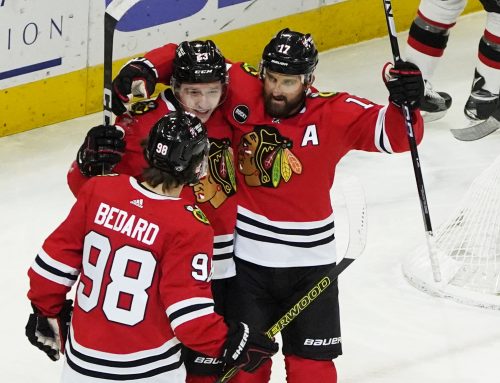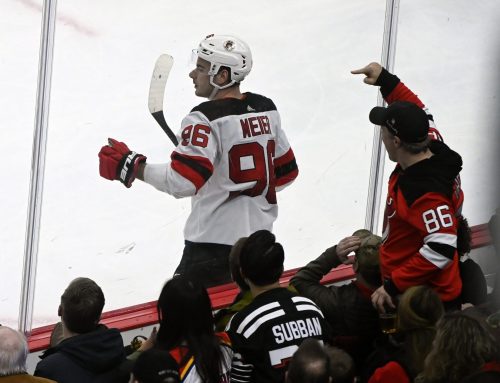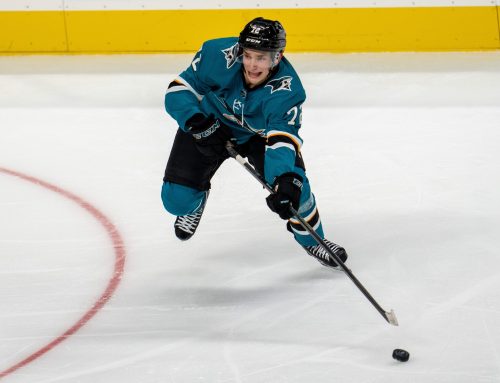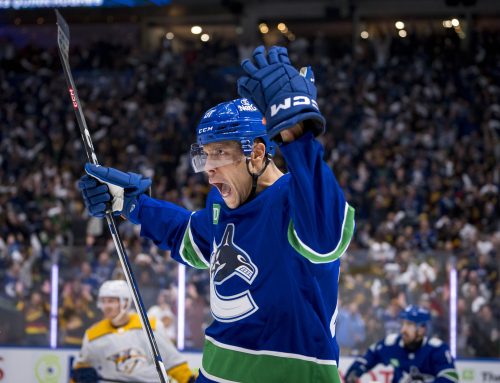Ramblings: Blues Romp, Pittsburgh’s Depth, Draft Value Indicators (May 12)
Michael Clifford
2016-05-11

Rambling: Stars implode, Value Indicators for Drafts, Pittsburgh’s Re-tool
****
Well, this one was pretty much over after the first 20 minutes. Robby Fabbri potted a goal for his 11th point of these playoffs about five minutes in. After a disallowed Blues goal thanks to an offside, Paul Stastny snuck one past the short side on Kari Lehtonen from a bad angle, and it was a bad goal. In the final second of the period, Patrik Berglund let go of a wrister from inside the blue line that looked to change directions off his own player – which, I have no idea why two guys were getting down to block a 55-foot wrist shot with no Blues players in front – and beat Lehtonen. The Blues would take a 3-0 lead into the first intermission.
St. Louis added two in the second and it was just riding the game out from there. The Stars weren’t particularly bad, and had their chances to score (it could have easily been 5-2 after the second instead of 5-0). With that said, after Lehtonen probably won them Game 6, the goaltending lost them Game 7. So it goes.
Also, the legend of Robby Fabbri grows…
Robby Fabbri becomes the youngest player in #NHL history to record 3 points in a game 7 #stlblues
— Andy Strickland (@andystrickland) May 12, 2016
****
With the benefit of hindsight, seems kind of foolish that Tyler Seguin came back for a game against the Wild, right? I know they say the injury he’s going through now isn’t the Achilles problem that began this whole process, but I find it hard to believe it’s in no way related.
This is basically the reason why, as a Habs fan, I couldn’t understand the pressure to get Carey Price games in the last couple weeks of the season. It would have been to no benefit to the team, and could only hinder recovery. This should serve as a warning for teams in bringing back players before they’re 100-percent, even in playoff time.
****
The clinching win by the Penguins over the Capitals just highlighted what had been the problem for Pittsburgh in recent years: depth. Having superstars is always a key to a deep Cup run – Los Angeles and Chicago are proof of that – but the third/fourth lines, along with the non-top defence pairings, are very important as well.
There was a great post by Tyler Dellow a.k.a. Mc79Hockey a couple of years ago about Pittsburgh’s depth problems, namely production and being dominated without one of Evgeni Malkin or Sidney Crosby on the ice. Once Dellow was hired by the Oilers, though, all his posts were taken down. Just google search for stats-based articles on Pittsburgh from the last four or five years going into the playoffs. I think Travis Yost of TSN did one a couple of years ago.
General manager Jim Rutherford deserves a lot of credit for the Penguins being in the position they are in. That entire “third” line of Bonino/Hagelin/Kessel were acquired in trades. They added Trevor Daley to bolster the blue line, and he has six points in 11 games so far these playoffs. Eric Fehr and Matt Cullen were both signed in the offseason. With a few shrewd moves, the Penguins went from no depth to four solid lines, and an actual second defence pair.
Again, yes, Crosby/Malkin/Letang are the core to build around. But the depth is quite often the difference between winning teams and losing ones. The coaching change was the catalyst to the season the Penguins are now enjoying, but the building blocks to their Eastern Final run were put in place in the summer.
****
Part of the job for anyone who writes about fantasy sports is to teach. It’s not simply spouting facts (or falsehoods), and having everyone nod in agreement. Part of the job is to ensure others are learning.
There are indicators that can be used to look for value in next year’s drafts. There are a lot of them, actually; individual points percentage (IPP) regression, on-ice shooting percentage, shot rate, expected line mates, expected usage, first/second assist rates, goals per 60 minutes, and a whole host of other data points. Here are a couple I use when looking for value.
Goals per 60 minutes at five-on-five (from Hockey Analysis)
This one is to be used with extreme caution. Goal rates can fluctuate wildly in a single season, through shot percentage variance, rise/drop in shot rate due to age-related progression/decline, adjusted usage, and more. One area where I find it helps a lot – and I would use at least two seasons of data to judge this – is identify depth players that could be looking at expanded roles the following year. This is the exact reason why I was so high on Tyler Toffoli coming into this year.
One guy that jumps out to me immediately is Jason Zucker. On a per minute basis, Zucker has the same goal rate over the last two seasons as Max Pacioretty and Brandon Saad, tied for 12th among all NHL forwards with at least 1500 minutes played.
His shooting percentage of 11.43-percent at five-on-five is a bit high, but it’s not extreme, as it ranks outside the top-50 in that span.
Zucker seemed to fall out of favour as the season wore on, being a healthy scratch at times, and posting just four goals in his final 35 games. The thing is, it’s not like he wasn’t getting his chances. In fact, he was second on the Wild in individual high-danger scoring chances, trailing only Zach Parise (and he played about 40 fewer minutes than Parise at five-on-five). The hextally below from War On Ice shows he generated nearly four more shots per 60 minutes than the average NHL player in the low-to-mid slot:

For reference, Jamie Benn was at 1.18, and Pacioretty at 2.63. Zucker was, officially, at 3.97 shots from the low-to-mid slot above average. That’s really good.
With a new coach, hopefully it leads to a regular usage for Zucker. I’m not sure if he gets enough top power play time to really contribute PPPs, but with a bit of a bounce-back and regular ice time, Zucker can be a 20-25 goal guy who will be essentially free come fantasy draft day.
Individual Points Percentage (IPP)
Those that have read my Ramblings know may be versed in this, but for the uninitiated, IPP is the rate at which a player manages a point (goal or assist) on a goal scored with them on the ice, and is almost always expressed at five-on-five.
One caveat here is that looking at the top-10 from this year, you see names like Duchene, Patrick Kane, Tavares, Draisaitl, Hall, Crosby. So, yeah, good players touch the puck frequently on goals scored with them on the ice. Conversely, the bottom is populated by players like Wilson, Connolly, Chiasson, Larsson, Lewis, and others. In other words, less skilled players score fewer points when they’re on the ice. File all this under, “No duh.”
What’s important to look for is significant deviations from what a player normally does. Hall was in the top-10, and over 84-percent last year. Looking at his past, two of the three seasons before 2015-2016 were over 94-percent. So, yeah, 84-percent is high, but not for him. It’s not a personal outlier.
One guy I’m targeting next year will be Nathan MacKinnon. He’ll obviously cost a lot more on draft day than Zucker will, but MacKinnon was going in the third round (25-36 pick) range fairly frequently last year, and surely not outside the top-50. I think a down year will get people to take him more in the 37-48 range, though not much has really changed for him besides getting another year under his belt.
MacKinnon’s IPP last year was 62.2-percent, nestled between Adam Lowry and Ryan Garbutt. The two years before that were 80.6-percent, and 72.7-percent. His IPP dropped so much, this happened:
MacKinnon had 29 five-on-five points in his injury-shortened 2014-2015 season. MacKinnon had 28 five-on-five points this past year, despite 170 more minutes of ice time *and* the team having a higher goals-for per minute than the previous season. So, MacKinnon had 170 more minutes, the team scored more often, and even with all that, MacKinnon had one fewer five-on-five point than the year before. A big reason was his dive in IPP.
This young star is supremely talented, and is entering his fourth full season. The team he’s on is bad, but he is very good. I wouldn’t be the least bit surprised to see a 30-goal, 70-point season from him next year.
****
Seeing as the World Cup is a sham best-on-best tournament, fans need to make do with what they’re given. Sure, fans of Canada, the United States, and the rest of the single countries have their own rooting interests. I can’t be the only one really looking forward to watching the Young Guns team, though?
The hockey world is going to be treated to having Jack Eichel, Connor McDavid, Johnny Gaudreau, Dylan Larkin, Nathan MacKinnon, Brandon Saad, Aaron Ekblad, Seth Jones, Morgan Rielly, Matt Murray, and a whole host of other top, young talents all on the same team. This will be fun.
In all honesty, aside from blindly rooting for Canada, I can’t wait to watch that young team. This is a special group of players, something probably not seen since post-2005 lockout. The chance to watch them all play together against the best in the world will be incredible to watch. I hope fans get to appreciate the collection of talent on this team. It could be some time before we see it again.
****
Speaking of McDavid, something I’ve started to wrestle with is this: Where does McDavid rank next year in re-draft (one-year) season-long leagues? Specifically in roto leagues.
I think most would agree that Alex Ovechkin is the number-1 next year. Does Crosby fit as the number-2, or is it McDavid? Is he a top-5, or a top-10 pick?
McDavid’s 10.14 on-ice shooting percentage at five-on-five (the rate at which the Oilers scored with him on the ice) is very high, but I’m not sure it’s far out of line. It’s pretty much commensurate with other elite talents over the last couple of years like Gaudreau and Kucherov. Besides, any drop in on-ice SH% is probably mitigated by getting more ice time anyway.
I know it’s easy to scoff at a half-season sample for an 18-year old, but there’s really nothing to suggest McDavid isn’t the next generational player. He was an elite offensive driver as a rookie: he was top-10 in high-danger scoring chance differential relative to his team in the entire league; he was as proficient at driving shot attempts relative to his team as Jamie Benn and Ryan Getzlaf; he’s only getting better.
After Ovechkin, there’s a case to be made for McDavid at number-2. What say you?
****
Just to get a general feel, and let me know in the comments, where do you rank John Carlson, fantasy-wise, among defencemen next year?
*Some stats from Hockey Reference, Hockey Analysis, and War On Ice
6 Comments
Leave A Comment
You must be logged in to post a comment.





 T.B
T.B FLA
FLA NYI
NYI CAR
CAR TOR
TOR VGK
VGK VAN
VAN EDM
EDM MIN
MIN STL
STL

I highlighted IPP in my Cage Match article on MacKinnon from a couple of months ago, but it might even be simpler than that. During MacKinnon’s 24 points in 24 games to start this season, he had 20:00+ in Ice Time 15 times (seven times 21:00+), while in 48 games after that he crossed the 20:00 threshold only 14 times (with just four of 21:00+).
I think Patrick Kane has to be considered in the Top 3 in single year leagues next year as well.
Nice Ramblings, Mike. Johnny Carlson is a horse and should be taken in the top 8 or 9 defenders depending on league scoring.
Not sure what roto is, most people just use points. And yes McDavid would be the #1 pick
Dellow article mentioned in the article (i believe):
http://archive.is/KZ6YK
You are not alone, Michael. I think the Young team will be fascinating to watch…and I’ve felt that since the tourney was announced. Great roster.